Ecology - Biodiversity & Conservation Questions and Answers

Biology
Ecology - Biodiversity & ConservationCreating biosphere reserves are important for species conservation. Which of the following is an important feature that should accompany the creation of these reserves?
A. prey-proof fences
B. signs asking visitors to please feed the animals
C. protected migration routes that lead to and from the various

Biology
Ecology - Biodiversity & ConservationHomeostasis is a tendency to remain more or less stable. In nature, this is maintained primarily by A. overuse of resources. B. the lithosphere. C. negative feedback loops. D. exponential growth.

Biology
Ecology - Biodiversity & ConservationSeveral factors determine the distribution of biomes on the planet. Which two are considered the major determining factors?
A. soil and mountain ranges
B. precipitation and temperature
C. altitude and proximity to the ocean
D. presence of mountain ranges and temperature
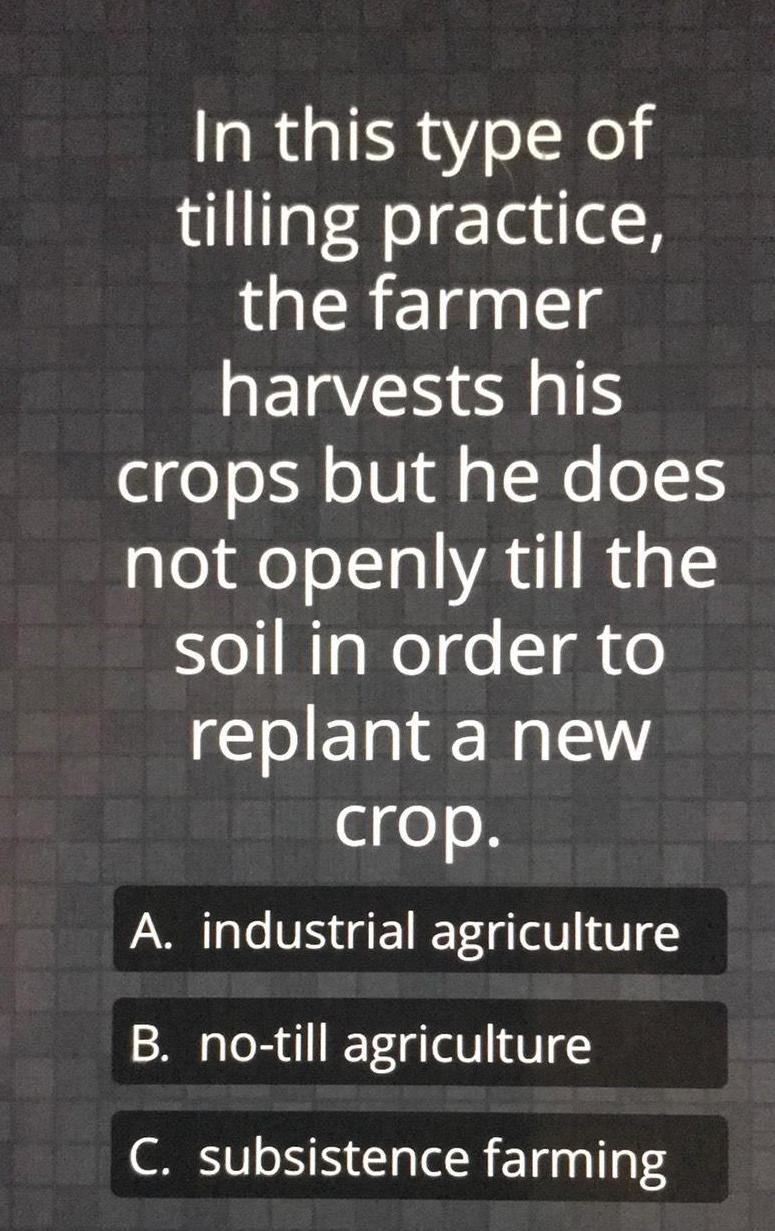
Biology
Ecology - Biodiversity & ConservationIn this type of
tilling practice,
the farmer
harvests his
crops but he does
not openly till the
soil in order to
replant a new
crop.
A. industrial agriculture
B. no-till agriculture
C. subsistence farming

Biology
Ecology - Biodiversity & ConservationWhich hypothesis CANNOT be tested?
Grass grows faster in the spring than in the summer.
People who eat large amounts of saturated fats are more likely to develop heart disease.
Bob has the knowledge to pass the written exam for his driver's license.
Egg shells are stronger when chickens are fed extra calcium.
The flowers growing on the west face of the mountain are more beautiful than those on the east face.

Biology
Ecology - Biodiversity & ConservationPlants are primary producers. Which term also refers to plants?
A. consumers
B. carnivore
C. producers
D. heterotroph

Biology
Ecology - Biodiversity & ConservationWhich of the
following most
directly limits
the number of
organisms in a
community?
A. UV radiation
B. amount of available shelter
C. wind
D. hours of daylight/day

Biology
Ecology - Biodiversity & ConservationTransition forest - overlap zones between needleleaf forests and deciduous forests
Appalachian Cove forest - climax forests known for high humidity and lush foliage
Northern Needleleaf forest - spruce-fir forests found on the highest, coolest peaks
Oak-Hickory forest - classic deciduous forests with abundant food and shelter
Shenandoah National Park is home to many different types of ecosystems. According to the characteristics shown above, which ecosystem would most likely be home to a mixture of wildlife species from northern, cooler ranges and southern, warmer ranges?
Northern Needleleaf forest
Oak-Hickory forest
Appalachian Cove forest
Transition forest

Biology
Ecology - Biodiversity & ConservationBiodiversity in an ecosystem refers to
the number of offspring produced each season by each species.
the number of different abiotic and biotic factors present.
the biological fitness of each individual.
the number of different species present and their relative abundance.

Biology
Ecology - Biodiversity & ConservationDiclofenac causes _______ percent of white-rumped vultures deaths.
A. 59
B. 99
C. 79
D. 49
Given all the 3 different steps of biodiversity loss, what is the total estimated percentage of species lost?
OA. 87
B. 10
OC. 26
OD. 29

Biology
Ecology - Biodiversity & ConservationWhat is the term we use to describe the difference between the number of known species and the number of species we estimate to be on earth?
Limited Thalweg
Centillenan Extinction
Linnean Shortfall
Quammen Query
Cretaceous Conundrum

Biology
Ecology - Biodiversity & ConservationWhich are true about salmon? choose all correct ones. aquaadvatage
a. by law, they must be raised in closed pens
b. aquaadvantage salmon has been genetically modified with a growth hormone from pacific chinook salmon
c. currently, they are raised exclusively in prince edward island
d. aquaadvantage salmon requires 25% less feed for the weight produced e. 100% aquaadvantage salmon are sterile.

Biology
Ecology - Biodiversity & ConservationBison in Yellowstone National Park have a food-limited carrying capacity that determines how their
population grows. If the population grows too large, some bison will either starve or migrate to search
for more food. The park is able to support a maximum population of 4,500 bison. Park conservation
officials must watch the population and prevent the bison from overpopulating, since they would migrate
to nearby farms, causing agricultural damage and creating hazards to drivers. The bison begin to migrate
when the population reaches 4,000 because of competition for food.
If the current population size of bison is 3,652 and the maximum growth rate of the population is 0.28,
calculate the population size after one year and determine whether the park will need to take measures to
control the population.
a. The population will be 3,845 after a year. The bison will not pose a problem until the following
year, and no conservation action will need to take place.
b. The population will be 4,675 after a year. Some bison will need to be removed to prevent
migration, since they will surpass the resource availability.
c. The population will be 1,023 after a year, since the growth rate is too low. Conservation efforts
will need to focus on increasing the bison population.
d. The population will be 4,500 after a year. The bison cannot exceed the carrying capacity, so they
will stop reproducing. Some bison will need to be removed.

Biology
Ecology - Biodiversity & ConservationWhich of the following statements does not pertain
to Streptococcus pyogenes?
Select one:
a. It is often spread from an endogenous source.
b. It secretes streptokinase.
c. It causes impetigo.
d. It coats itself with host proteins.
e. It causes gas gangrene.

Biology
Ecology - Biodiversity & ConservationThe emergence of many diverse species from a common ancestor such as the many lemurs species of Madagascar, when this common ancestor find itself stranded in a very diverse and new habitat, is called_________
a. sexual selection
b. disruptive selection
c. adaptive radiation
d. founder effect
e. hybridization

Biology
Ecology - Biodiversity & ConservationWhat is the significance of the reshuffled rivers of amazons hyper biodiversity to the society?
what part of biology is needed to understand the theme of reshuffled rivers of amazons. how this topic is related to other subjects such as maths, physical or social science.

Biology
Ecology - Biodiversity & ConservationIn this lesson, you learned about the process of cellular respiration, in which the cells of an organism use sugar and oxygen to produce energy and carbon dioxide.
Evaluate Why is it important to consider the process of cellular respiration when determining what is going wrong in the greenhouse?

Biology
Ecology - Biodiversity & ConservationExamples of habitat fragmentation include:
A) Cutting down forests for farmland.
B) Building roads & highways.
C) Erecting barriers like fences and walls.
D) All of the above represent examples of habitat fragmentation
E) Only A & B represent habitat fragmentation

Biology
Ecology - Biodiversity & ConservationPerformance Task 2: The Mayor now understands the importance, but doesn't understand how bee's are a part of our ecosystems. Create a model of how they are incorporated that explains how they affect us.

Biology
Ecology - Biodiversity & ConservationA paper mill was releasing harmful chemical waste into a nearby river. The paper mill worked with a group of environmental scientists to develop new, sustainable waste management protocols in order to minimize the amount of harmful chemicals being released into the river ecosystem.
Which of the following is a likely effect of the paper mill's sustainable waste management protocols?
Choose 1 answer:
A The chemical waste will have to be dumped in a different river, likely affecting fish and invertebrate populations in that ecosystem.
B The river will be more hospitable to fish, helping increase biodiversity within the river's fish populations.
C The paper mill will go out of business due to the extra costs of waste management.

Biology
Ecology - Biodiversity & ConservationWhich of the following statements best describes how biodiversity can benefit the health of a desert ecosystem?
Choose 1 answer:
A Having large populations of producers, such as cacti, ensures plentiful food for the desert's consumers.
B Greater species diversity makes the desert more resilient to disturbances, such as landslides.
CThe maintenance of populations at or above carrying capacity ensures plentiful mating opportunities for the desert's organisms.

Biology
Ecology - Biodiversity & ConservationWhich of the following is an example of how climate change negatively impacts biodiversity?
Choose 1 answer:
A Extreme weather fluctuations lead to more available ecological niches for populations of organisms to occupy.
B Species that cannot adapt to changing climate conditions are likely to go extinct.
C The burning of fossil fuels reduces the amount of energy available to the human population.

Biology
Ecology - Biodiversity & ConservationWhich statement best explains why biodiversity on Earth is decreasing?
Choose 1 answer:
A The current rate of extinction is greater than the current rate of speciation.
B The current rate of extinction and the current rate of speciation are equal.
C The current rate of speciation is greater than the current rate of extinction.

Biology
Ecology - Biodiversity & ConservationWhich plant adaptation would likely be found in the taiga?
A) aerial roots to avoid flooding
B) extremely large and broad leaves
C) small needle-like evergreen leaves
D) large fleshy stems that store water

Biology
Ecology - Biodiversity & ConservationRelating to society or its organization. "How do we relate to one another?"
Political
Social
Geography
Economics

Biology
Ecology - Biodiversity & ConservationWhich of the following is a possible cost of using renewable resources?
a. loss of animal species
b. land degradation
C. lower availability of freshwater
d. all of the above
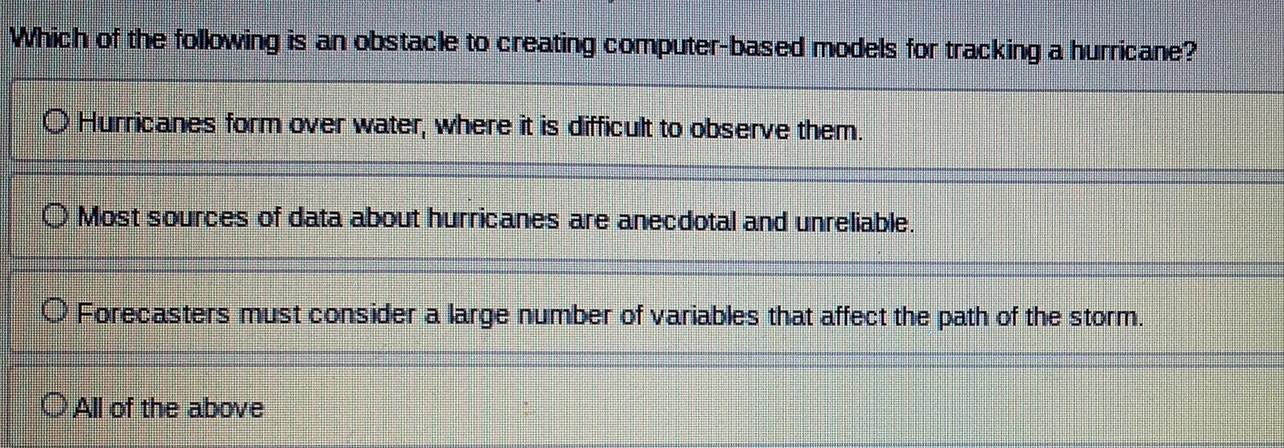
Biology
Ecology - Biodiversity & ConservationWhich of the following is an obstacle to creating computer-based models for tracking a hurricane?
Hurricanes form over water, where it is difficult to observe them.
Most sources of data about hurricanes are anecdotal and unreliable.
Forecasters must consider a large number of variables that affect the path of the storm.
All of the above

Biology
Ecology - Biodiversity & ConservationMost fertilizers contain ammonia (NH3). Ammonia forms when hydrogen reacts with nitrogen. Which equation correctly represents the chemical reaction that forms ammonia?
3H₂ + N₂ → NH3
H₂ + N₂ → 2NH3
H₂ + N₂ → NH3
3H₂ + N₂ → 2NH3

Biology
Ecology - Biodiversity & ConservationAt night, when gazing high up at an electrical tower, one might notice a blinking light. Do y
knowhey do not hit them when flying low or when getting ready to land. Makes sense, right?
know the reason why there are lights up on tall towers? These bright lights warn planes
However, did you know that those lights were intially only solid beams? Later, regulations
were put in place to make the lights blink. Is the reason for the change so planes can see
them better? Not exactly! The reason why the lights blink rather than stay on steadily
is because birds were actually crashing into them. According to the Federal Aviation
Administration, the solid lights were attracting the birds and disorienting them, and many
lost their lives after crashing into the electrical towers. By mandating the change to blinking
lights, planes and birds are now safe.
What is one supporting detail that supports the main idea?

Biology
Ecology - Biodiversity & ConservationWhat happens to the fitness of a male lion that is displaced by a more dominant male that then kills all cubs in the pride?
The displaced male will have higher fitness.
The fitness of the displaced and dominant males will be the same as before.
This does not affect the fitness of either lion.
The displaced male will have lower fitness.

Biology
Ecology - Biodiversity & ConservationSpecies A is a mainland bird species. A small group of species A birds is blown onto a nearby island. The resources on the island are different from those on the mainland, and soon the population evolves into species B because there is no contact with birds from the mainland population.
Which two factors contributed to the rapid development of species B?
An increase in gene flow between the two populations
A large gene pool in the island population
A reduction in gene flow between the populations
A small gene pool in the island population

Biology
Ecology - Biodiversity & ConservationWild salmon spend most of their lives in the ocean but return to freshwater rivers to spawn, or reproduce. Most wild salmon will only spawn in specific spawning grounds in the rivers in which they were born. The construction of hydroelectric dams in rivers has blocked the paths of some salmon returning to their spawning grounds. This has led to population declines. Which method would be most effective in preventing further wild salmon population declines caused by the construction of hydroelectric dams?
A. observing the migration patterns of wild salmon by tagging and tracking a small sample of fish
B. constructing passageways next to dams to allow salmon to swim around blocked rivers
C. establishing protected regions around wild salmon spawning grounds in specific rivers
D. monitoring genetic diversity by using netting to catch salmon and obtain genetic samples

Biology
Ecology - Biodiversity & ConservationSelect the correct answer.
What do scientists call regions of Earth that contain an unusually large number of species that are threatened by habitat loss?
A) nature reserve
B) conservation area
C) biological augmentation
D) biodiversity hotspot
E) bio remediated areas

Biology
Ecology - Biodiversity & ConservationWhat do scientists call regions of Earth that contain an unusually large number of species that are threatened by habitat loss?
A. nature reserve
B. conservation area
C. biological augmentation
D. biodiversity hotspot
E. bio remediated areas

Biology
Ecology - Biodiversity & ConservationSelect the correct answer.
Biologists notice that a population of ferrets introduced into a reserve begins to show exponential growth. The figures represent the population of the ferrets for the first four years after their introduction. Which set of figures represents the exponential growth of the ferrets?
A) 50, 88, 145, 227
B) 50, 92, 90, 95
C) 50, 32, 17,9
D) 50, 95, 59, 97

Biology
Ecology - Biodiversity & ConservationWhich of the following feature group can be found on an erosional coastline?
sea stacks, arches, caves and wave cut platforms
spits, barrier islands, lagoons and tombolos

Biology
Ecology - Biodiversity & ConservationThe Chinese scientist and team who are responsible for cloning the monkeys believe that cloning monkeys is a worthwhile endeavor.
Which answer choice BEST explains how PETA's perspective is different?
PETA thinks that cloning monkeys raises too many safety concerns.
PETA thinks that cloning monkeys is a waste of valuable resources.
PETA believes that cloning monkeys leads to cloning humans.
PETA believes that cloning monkeys has few benefits.

Biology
Ecology - Biodiversity & ConservationIn science class, Eric learns about relationships between organisms in
nature. The concepts of predation and parasitism tend to confuse him.
Which explains the difference between these two concepts?
Parasitism results in two organisms benefiting while in predation only one organism benefits.
Parasitism happens quickly, but predation happens over time.
Predation results in the death of one organism while in parasitism the host may only be harmed.
Predation and parasitism are the same thing, since only one organism is harmed in each relationship.

Biology
Ecology - Biodiversity & ConservationThe first sentence of this selection states, "Some forty years ago, I spent the winter in a cabin in the wild areas of northern Maine." This is a clue that the narrator
A is a character in the story.
B knows the thoughts of all the characters.
C is not a character in the story.
D changes throughout the story.

Biology
Ecology - Biodiversity & ConservationTrees are not usually found in the tundra biome because of
overbrowsing by musk ox and caribou.
insufficient annual precipitation.
acidic soils.
permafrost.

Biology
Ecology - Biodiversity & ConservationThe Himalayas are home to over peaks over 23,000, feet high.
100
150
200
250

Biology
Ecology - Biodiversity & ConservationEating unhealthy foods poses a health and economic cost to society. Taxing unhealthy foods can help government recoup such costs and can be used to help governments justify intervening with taxes.
True
False
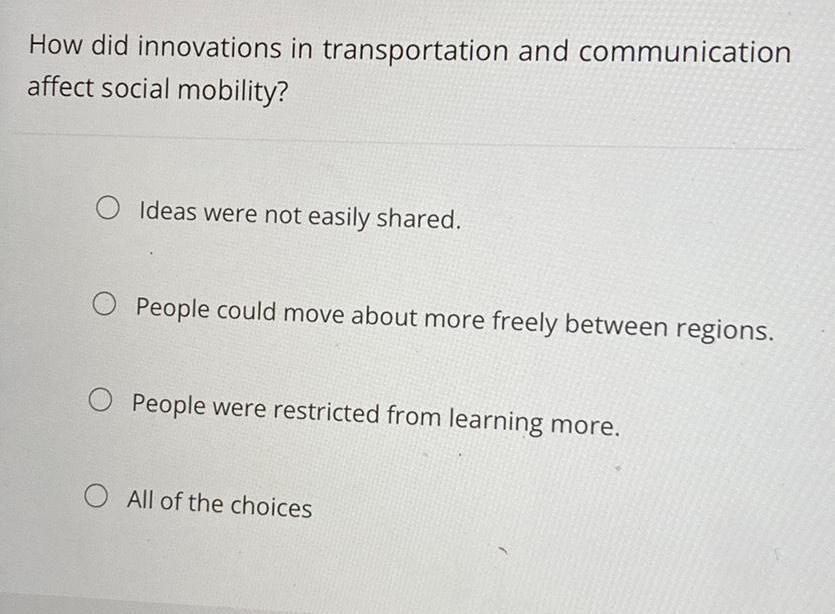
Biology
Ecology - Biodiversity & ConservationHow did innovations in transportation and communication affect social mobility?
Ideas were not easily shared.
People could move about more freely between regions.
People were restricted from learning more.
All of the choices

Biology
Ecology - Biodiversity & ConservationGrazing animals such as bison and burrowing animals such as prairie dogs are common animals to what terrestrial biome?
Temperate grasslands
Desert
Tropical Forest
Intertidal Zones
Temperate grasslands

Biology
Ecology - Biodiversity & ConservationMany species of lizards have colored patches along the sides of their bodies. In one species, males have blue patches and females have red patches. Males of this species show aggressive behavior towards other males, but not towards females with whom they try to mate. Which of the following would allow you to directly assess whether blue coloration was a stimulus for aggressive behavior?
Obtain a male lizard from a different species that has yellow patches on its sides and observe whether males are aggressive towards the male of the other species
Paint the red patches on a female lizard blue and observe whether males are aggressive towards the painted female
Paint the blue patches on a male lizard red and observe whether males try to mate with the painted male
Obtain a female lizard from a different species that also has red patches on its sides and observe whether males try to mate with the female of the other species

Biology
Ecology - Biodiversity & ConservationAll flying birds and insects have wings. Birds and insects flap their wings as they move through the air. Therefore, wings enable flight. Is this an example of inductive or deductive reasoning?
A. inductive
B. deductive

Biology
Ecology - Biodiversity & ConservationComplete this sentence:
Predation is different from parasitism because
one organism needs a host with predation.
one organism is harmed with predation.
one organism is killed with predation.
one organism remains unaffected with predation.

Biology
Ecology - Biodiversity & ConservationWhich of the following statements are true?
Communities exist within ecosystems, which exist in the biosphere.
Organelles exist within cells, which exist within tissues.
Communities exist within populations, which existithin ecosystems.
Tissues exist within organs, which exist within organ systems.
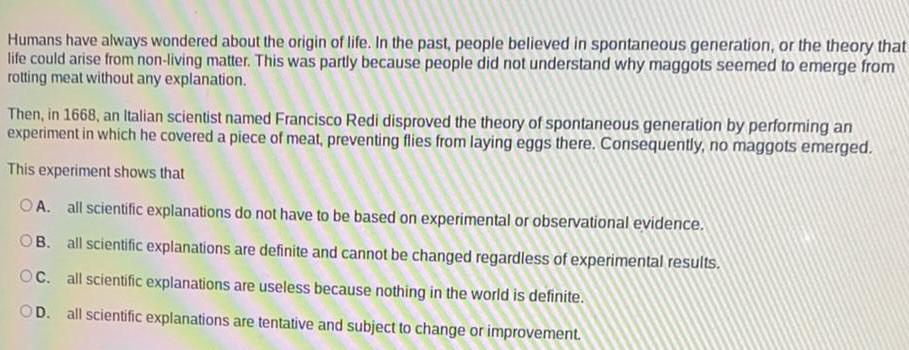
Biology
Ecology - Biodiversity & ConservationHumans have always wondered about the origin of life. In the past, people believed in spontaneous generation, or the theory that life could arise from non-living matter. This was partly because people did not understand why maggots seemed to emerge from rotting meat without any explanation.
Then, in 1668, an Italian scientist named Francisco Redi disproved the theory of spontaneous generation by performing an experiment in which he covered a piece of meat, preventing flies from laying eggs there. Consequently, no maggots emerged.
This experiment shows that
A. all scientific explanations do not have to be based on experimental or observational evidence.
B. all scientific explanations are definite and cannot be changed regardless of experimental results.
C. all scientific explanations are useless because nothing in the world is definite.
D. all scientific explanations are tentative and subject to change or improvement.
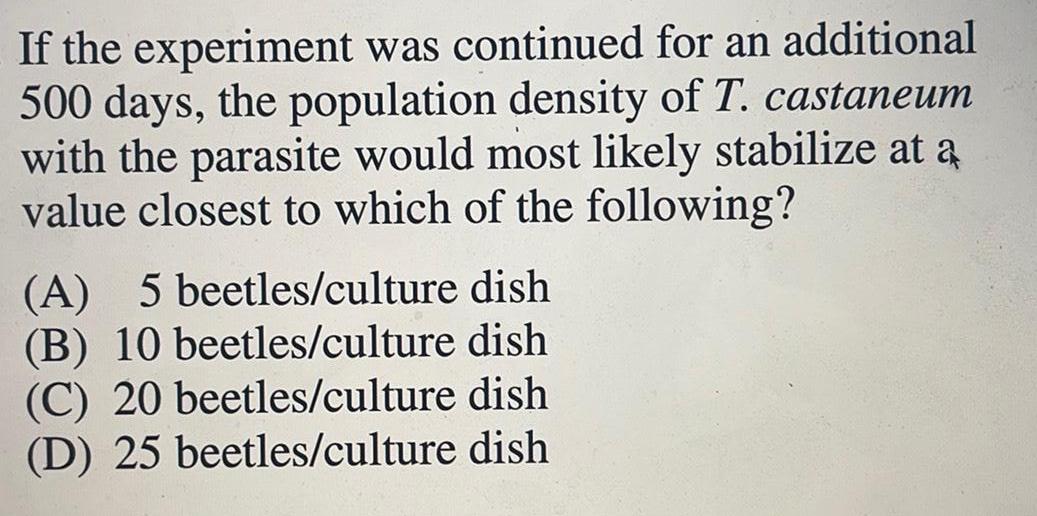
Biology
Ecology - Biodiversity & ConservationIf the experiment was continued for an additional 500 days, the population density of T. castaneum with the parasite would most likely stabilize at a value closest to which of the following?
(A) 5 beetles/culture dish
(B) 10 beetles/culture dish
(C) 20 beetles/culture dish
(D) 25 beetles/culture dish